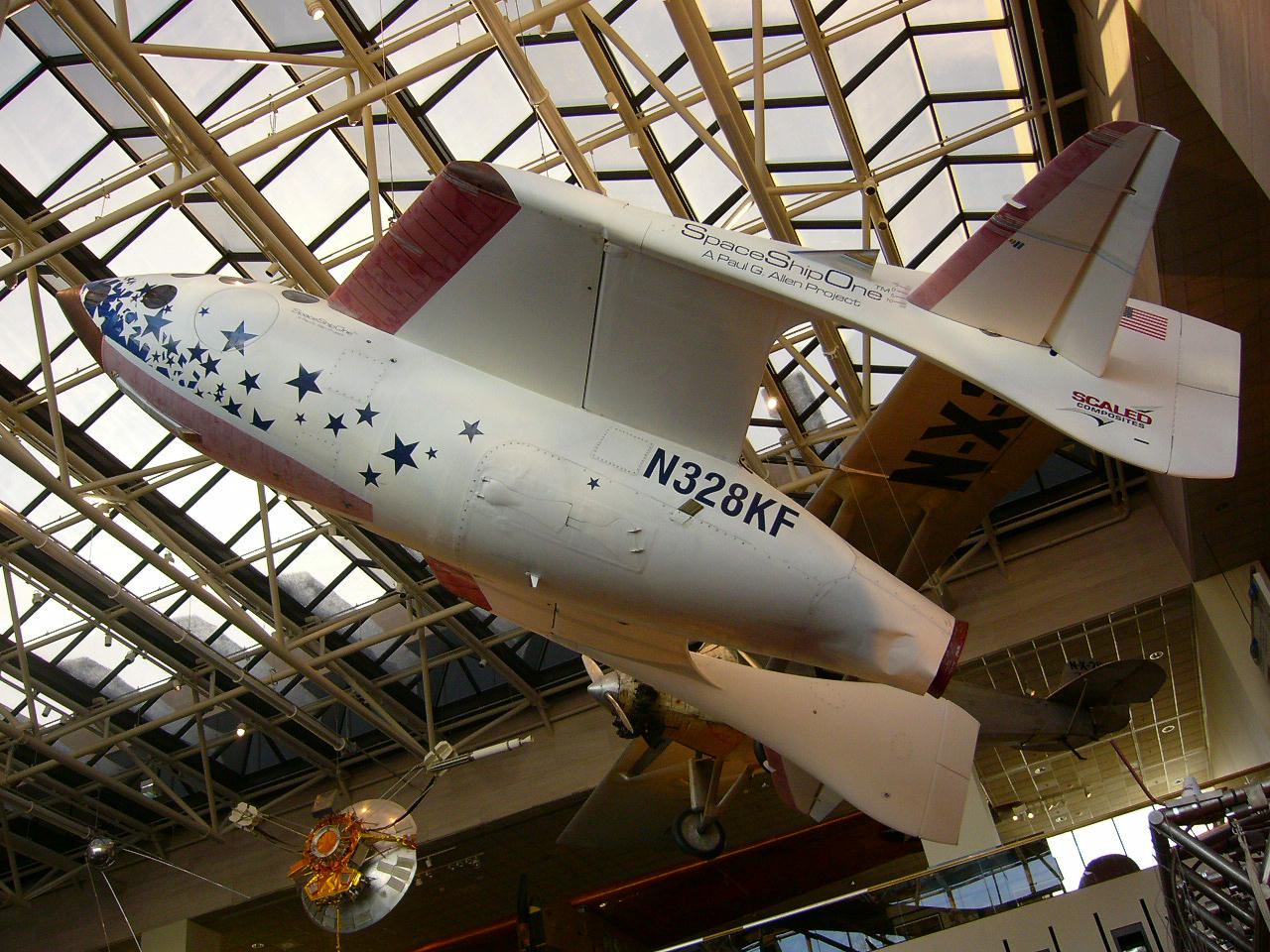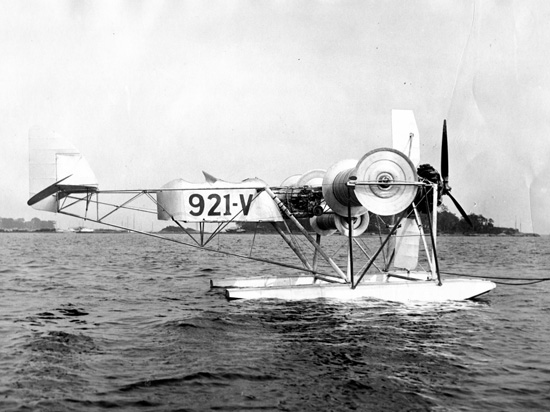|
FanWing
The FanWing is an aircraft configuration in which a horizontal-axis cross-flow fan is used in close conjunction with a fixed wing. The fan forces airflow over the fixed surface to provide both lift and forward thrust. The concept was initially developed around 1997 by designer Patrick Peebles and is under development by his company FanWing Ltd. As of December 2018, only experimental drones have been flown. Principles of operation A cross-flow fan comprises blades radiating from a central axis and aligned with the axis, similar to those of a cylinder mower. It is contained in a duct which is shaped so that when the fan spins, it induces a directional airflow. In the FanWing, the fan is set above the leading section of a fixed wing and extends the full span of the wing. The wing upper surface is shaped around the fan to form a half-duct. The wing chord extends approximately as far again back from the fan, with the rear section shaped as a wedge-like fairing that extends to the trai ... [...More Info...] [...Related Items...] OR: [Wikipedia] [Google] [Baidu] |
Outboard Tail
An outboard tail is a type of aircraft tail or empennage which is split in two, with each half mounted on a short boom just behind and outboard of each wing tip. It comprises outboard horizontal stabilizers (OHS) and may or may not include additional boom-mounted vertical stabilizers (fins). OHS designs are sometimes described as a form of tailless aircraft. The outboard tail surfaces are positioned so that they interact constructively with the wingtip vortices to significantly reduce drag, without causing undue structural or handling difficulties. Characteristics An outboard tail is located outboard of the main wing tips. Although sometimes described as tailless, the outboard tail configuration differs from a tailless wing in that the horizontal stabilizer is discontinuous from the main wing surface, typically being set further back and requiring a short boom to support it. If the wing is swept, then the boom can be very short and the front of the tail may overlap the rear of t ... [...More Info...] [...Related Items...] OR: [Wikipedia] [Google] [Baidu] |
Flettner Airplane
A Flettner airplane is a type of rotor airplane which uses a Flettner rotor to provide lift. The rotor comprises a spinning cylinder with circular end plates and, in an aircraft, spins about a spanwise horizontal axis. When the aircraft moves forward, the Magnus effect creates lift. Anton Flettner, after whom the rotor is named, used it successfully as the sails of a rotor ship. He also suggested its use as a wing for a rotor airplane. The Butler Ames Aerocycle was built in 1910 and tested aboard a warship. There is no record of it having flown. The Plymouth A-A-2004 was built for Zaparka in 1930 by three anonymous American inventors. It was reported to have made successful flights over Long Island Sound. An inherent safety concern is that if power to the rotating drums were lost—even if thrust was maintained—the aircraft would lose its ability to generate lift as the drum slowed and it would not be able to sustain flight. See also * Cyclogyro * FanWing * Servo tab __N ... [...More Info...] [...Related Items...] OR: [Wikipedia] [Google] [Baidu] |
Flight International
''Flight International'' is a monthly magazine focused on aerospace. Published in the United Kingdom and founded in 1909 as "A Journal devoted to the Interests, Practice, and Progress of Aerial Locomotion and Transport", it is the world's oldest continuously published aviation news magazine. ''Flight International'' is published by DVV Media Group. Competitors include Jane's Information Group and ''Aviation Week''. Former editors of, and contributors include H. F. King, Bill Gunston, John W. R. Taylor and David Learmount. History The founder and first editor of ''Flight'' was Stanley Spooner. He was also the creator and editor of ''The Automotor Journal'', originally titled ''The Automotor Journal and Horseless Vehicle''.Guide To British Industrial History: Biographies: ''Stan ... [...More Info...] [...Related Items...] OR: [Wikipedia] [Google] [Baidu] |
Gyroplane
An autogyro (from Greek and , "self-turning"), also known as a ''gyroplane'', is a type of rotorcraft that uses an unpowered rotor in free autorotation to develop lift. Forward thrust is provided independently, by an engine-driven propeller. While similar to a helicopter rotor in appearance, the autogyro's rotor must have air flowing across the rotor disc to generate rotation, and the air flows upwards through the rotor disc rather than down. The autogyro was invented by Spanish engineer Juan de la Cierva in an attempt to create an aircraft that could fly safely at low speeds. He first flew one on 9 January 1923, at Cuatro Vientos Airfield in Madrid. The aircraft resembled the fixed-wing aircraft of the day, with a front-mounted engine and propeller. Cierva's autogyro is considered the predecessor of the modern helicopter. The success of the autogyro garnered the interest of industrialists and under license from Cierva in the 1920s and 1930s, the Pitcairn & Kellett compani ... [...More Info...] [...Related Items...] OR: [Wikipedia] [Google] [Baidu] |
Ornithopter
An ornithopter (from Greek ''ornis, ornith-'' "bird" and ''pteron'' "wing") is an aircraft that flies by flapping its wings. Designers sought to imitate the flapping-wing flight of birds, bats, and insects. Though machines may differ in form, they are usually built on the same scale as flying animals. Larger, crewed ornithopters have also been built and some have been successful. Crewed ornithopters are generally either powered by engines or by the pilot. Early history Some early crewed flight attempts may have been intended to achieve flapping-wing flight, but probably only a glide was actually achieved. They include the purported flights of the 11th-century Catholic monk Eilmer of Malmesbury (recorded in the 12th century) and the 9th-century poet Abbas Ibn Firnas (recorded in the 17th century). Roger Bacon, writing in 1260, was also among the first to consider a technological means of flight. In 1485, Leonardo da Vinci began to study the flight of birds. He grasped that human ... [...More Info...] [...Related Items...] OR: [Wikipedia] [Google] [Baidu] |
Rotary-wing Aircraft
A rotorcraft or rotary-wing aircraft is a heavier-than-air aircraft with rotary wings or rotor blades, which generate lift by rotating around a vertical mast. Several rotor blades mounted on a single mast are referred to as a rotor. The International Civil Aviation Organization (ICAO) defines a rotorcraft as "supported in flight by the reactions of the air on one or more rotors". Rotorcraft generally include aircraft where one or more rotors provide lift throughout the entire flight, such as helicopters, autogyros, and gyrodynes. Compound rotorcraft augment the rotor with additional thrust engines, propellers, or static lifting surfaces. Some types, such as helicopters are capable of vertical takeoff and landing. An aircraft which uses rotor lift for vertical flight but changes to solely fixed-wing lift in horizontal flight is not a rotorcraft but a convertiplane. Classes of rotorcraft Helicopter A helicopter is a rotorcraft whose rotors are driven by the engine(s) througho ... [...More Info...] [...Related Items...] OR: [Wikipedia] [Google] [Baidu] |
Aviation Week & Space Technology
''Aviation Week & Space Technology'', often abbreviated ''Aviation Week'' or ''AW&ST'', is the flagship magazine of the Aviation Week Network. The weekly magazine is available in print and online, reporting on the aerospace, defense and aviation industries, with a core focus on aerospace technology. It has a reputation for its contacts inside the United States military and industry organizations. ''Aviation Week'' was a favorite conduit for defense-related companies and labs to leak information to the public as part of their policy by press release efforts. This led to it being informally referred to "Aviation Leak and Space Mythology". History The magazine was first published in August 1916. Early editors Ladislas d'Orsy and Donald W. McIlhiney (1921 to 25) were Quiet Birdmen. Publisher (1927 to 29) Earl D. Osborn was also a Quiet Birdman. With the coming of the Space Age, the current title was adopted in 1960. Other titles the magazine has held include ''Aviation & Aircraft ... [...More Info...] [...Related Items...] OR: [Wikipedia] [Google] [Baidu] |
German Aerospace Center
The German Aerospace Center (german: Deutsches Zentrum für Luft- und Raumfahrt e.V., abbreviated DLR, literally ''German Center for Air- and Space-flight'') is the national center for aerospace, energy and transportation research of Germany, founded in 1969. It is headquartered in Cologne with 35 locations throughout Germany. The DLR is engaged in a wide range of research and development projects in national and international partnerships. DLR also acts as the German space agency and is responsible for planning and implementing the German space programme on behalf of the German federal government. As a project management agency, DLR coordinates and answers the technical and organisational implementation of projects funded by a number of German federal ministries. As of 2020, the German Aerospace Center had a national budget of €1.261 billion. Overview DLR has approximately 10.000 employees at 30 locations in Germany. Institutes and facilities are spread over 13 sites, ... [...More Info...] [...Related Items...] OR: [Wikipedia] [Google] [Baidu] |
STOL
A short takeoff and landing (STOL) aircraft is a conventional fixed-wing aircraft that has short runway requirements for takeoff and landing. Many STOL-designed aircraft also feature various arrangements for use on airstrips with harsh conditions (such as high altitude or ice). STOL aircraft, including those used in scheduled passenger airline operations, have also been operated from STOLport airfields which feature short runways. Design considerations Many fixed-wing STOL aircraft are bush planes, though some, like the de Havilland Canada Dash-7, are designed for use on prepared airstrips; likewise, many STOL aircraft are taildraggers, though there are exceptions like the PAC P-750 XSTOL, the Quest Kodiak, the de Havilland Canada DHC-6 Twin Otter and the Peterson 260SE. Autogyros also have STOL capability, needing a short ground roll to get airborne, but capable of a near-zero ground roll when landing. Runway length requirement is a function of the square of the minimum ... [...More Info...] [...Related Items...] OR: [Wikipedia] [Google] [Baidu] |
SMART (grant Scheme)
Smart or SMART may refer to: Arts and entertainment * ''Smart'' (Hey! Say! JUMP album), 2014 * Smart (Hotels.com), former mascot of Hotels.com * ''Smart'' (Sleeper album), 1995 debut album by Sleeper * ''SMart'', a children's television series about art on CBBC Businesses and brands * S-Mart, a Mexican grocery store chain * SMART (advertising agency), an Australian company * SmartCell, a network operator in Nepal * Smart Communications, a cellular service provider in the Philippines * Smart Technologies, a company providing group collaboration tools * Smart Telecom, a network operator in the Republic of Ireland * Smart (cigarette), an Austrian brand * Smart (drink), a brand of fruit-flavored soda produced by The Coca-Cola Company for Mainland China Computing * Smart device, an electronic device connected to other devices or networks wirelessly * Self-Monitoring, Analysis, and Reporting Technology (S.M.A.R.T.), a standard used in computer storage devices * SMART Informat ... [...More Info...] [...Related Items...] OR: [Wikipedia] [Google] [Baidu] |
Cross-flow Fan
Crossflow may refer to: * Ford Crossflow, the 1967 version of the Ford Kent engine * Crossflow cylinder head * Cross-flow fan, a type of mechanical fan * Cross-flow filtration, a filtration technique * Cross-flow turbine A cross-flow turbine, Bánki-Michell turbine, or Ossberger turbine''E.F. Lindsley,'' Water power for your homePopular Science, May 1977, Vol. 210, No. 5 87-93. is a water turbine developed by the Australian Anthony Michell, the Hungarian Donát B ..., a type of water (or air) turbine {{disambig ... [...More Info...] [...Related Items...] OR: [Wikipedia] [Google] [Baidu] |



.jpg)


